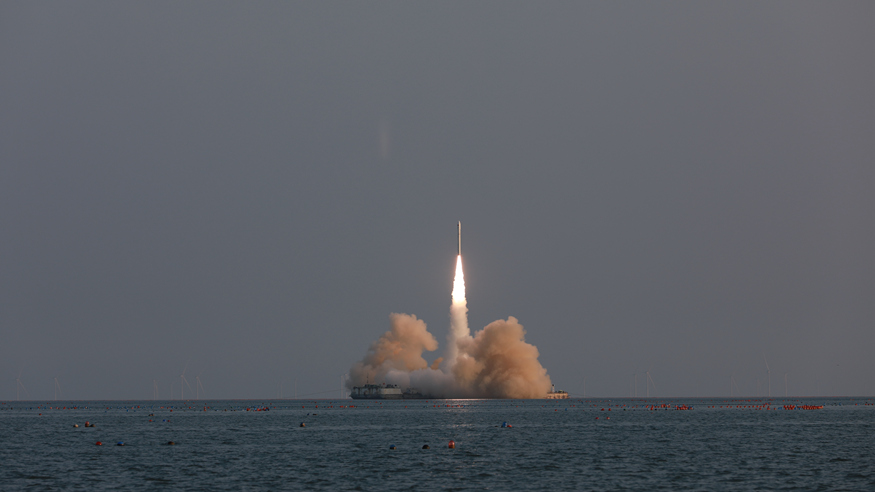
Xinhua Institute, the think tank of Xinhua News Agency, released a report on the "origins, facts and perils" of the U.S. military hegemony and held a seminar on the topic in Beijing, Sept. 5, 2023. (Xinhua/Cai Yang)
BEIJING, Sept. 7 (Xinhua) -- Xinhua Institute, the think tank of Xinhua News Agency, issued on Tuesday a report on the "Origins, Facts and Perils of U.S. Military Hegemony."
Following is the full text of the report:
Origins, Facts and Perils of U.S. Military Hegemony
Contents
Preface
Chapter I Formation of U.S. Military Hegemony
1.1 A Brief History of U.S. Military Hegemony
1.2 Root Cause of U.S. Military Hegemony
1.3 Fundamental Motives of U.S. Military Hegemony
Chapter II Acts and Means of the U.S. in Maintaining Military Hegemony
2.1 Explicit Control: Wars and Bases
2.2 Implicit Control: Alliances and Rules
2.3 New Models and Trend
Chapter III: Perils of U.S. Military Hegemony
3.1 Humanitarian Disasters
3.2 Violation of Sovereignty
3.3 Disruption of Order
3.4 Backlash
Conclusion
Preface
On August 30, 2021, the U.S. military cargo aircraft carrying the last batch of American troops took off from Hamid Karzai International Airport in Afghanistan, marking the end of the longest war in U.S. history. Mark Milley, chairman of the U.S. Joint Chiefs of Staff, later described the end of America's war in Afghanistan as a "strategic failure" when testifying before Congress. The military hegemony of the United States and its harm have once again aroused strong doubts at home and abroad.
The year 2023 also marks the 20th anniversary of the U.S. invasion of Iraq. This is an aggressive war waged by the United States against a sovereign state under the pretext of lies to pursue absolute security and realize its own geopolitical interests, which has brought heavy costs and has had a far-reaching impact on Iraq, the Middle East, the world at large, and the United States itself.
Since the American Independence in 1776, the United States has constantly sought expansion by force: It expanded its territory following the Mexican-American War, became a trans-regional power and penetrated into the Western Hemisphere and East Asia after the American-Spanish War, became a global superpower after the two world wars, and acquired the ability to project power and set rules around the world. The bipolar structure was replaced with unipolar hegemony after the Cold War, after which the United States achieved global military hegemony. Since then, the United States has been keen on maintaining its military hegemony by force and other means.
Throughout the 240-plus-year history of the United States, there were less than 20 years in which the country was not at war. The United States might as well be called the most belligerent country in the history of the world. According to incomplete statistics, from the end of World War II in 1945 to 2001, there were 248 armed conflicts in 153 regions of the world, of which 201 were initiated by the United States, accounting for about 81 percent. The United States has military tentacles all over the world and currently has about 750 military bases in at least 80 countries around the world. Among the 193 member states of the United Nations, about 175 countries have U.S. military personnel stationed there. Since 2001, the United States has launched wars and military operations in more than 80 countries around the world in the name of "anti-terrorism," which has directly resulted in the deaths of about 929,000 people, including 387,000 civilians, and the displacement or refugee status of about 38 million people.
During this process, the United States has followed an "imperial way of thinking" such as Manifest Destiny and American exceptionalism, and justified its hegemonic acts under the guise of the Sea Power theory and hegemonic stability theory. In its narrow pursuit of absolute power, interests and an ambition to dominate the land, the sea, the sky and even outer space, the United States has frequently launched wars and interfered in other countries' internal affairs, in an attempt to establish the so-called "Pax Americana," which is in fact a unipolar world subject to U.S. hegemony.
With its military hegemony, the United States has been promulgating hegemonic policies and actions, bringing tremendous harm to the whole world; destroying lives and human dignity, trampling on the sovereignty of other nations, disturbing the international order, hindering peaceful development, causing humanitarian disasters, jeopardizing global security and stability, impeding the progress of human civilization, as well as even harming itself.
This report, by presenting facts and data, aims to trace the root cause of U.S. military hegemony, to explore how the United States has pursued, maintained and abused its military hegemony, and to tell the truth about the perils of the practices of U.S. military hegemony to the whole world.
Chapter I Formation of U.S. Military Hegemony
Throughout U.S. history, many politicians have concealed America's ambition for world domination. They coveted "domination of the oceans, and all the seas," and predicted that the United States "may well be the most powerful and fearsome empire across the world in history." They imagined the American nation could "control the American continent first, which is but the prelude to global hegemony, and soon put the entire world under control," and claimed the advent of the "American Century."
History is a mirror. Seen from a broad perspective, the history of germination, rise, establishment, consolidation, and expansion of the U.S. military hegemony has coincided with the country's expansion from east to west, from land to sea, and from different regions to the world within the framework of the "imperial thinking" as its root.
1.1 A brief history of U.S. military hegemony
The history of U.S. military hegemony can be roughly divided into four stages: It was formed between the Mexican-American War and the American-Spanish War, was finally established between the two world wars, then met competition during the U.S.-Soviet Cold War, and has reached its peak since the end of the Cold War
-- The United States made preparations for acquiring hegemony from the Mexican-American War in the mid-19th century to the Spanish-American War in the late 19th century.
Following the independence and founding of the country, the United States initiated the "Westward Expansion" and the process lasted for nearly a hundred years. The Mexican-American War from 1846 to 1848 was the first major military operation of the United States outside its borders and the first time it occupied another country. The United States seized about 2.3 million square kilometers of land before and after the war, expanded over the North American continent, and gained access to the Pacific Ocean, thereby creating conditions for its subsequent military and economic expansion in the Pacific Ocean and East Asia.
At the end of the 19th century, calls for military expansion in the United States were on the rise, and the modernization of the U.S. Navy gradually advanced. The Spanish-American War in 1898 is considered to be the climax of the first imperialist era of the United States after its founding. In this first war of conquest outside North America, the United States defeated Spain and gained control over Cuba, Puerto Rico, the Philippines and Guam, and at the same time annexed Hawaii, which demonstrated that the United States was well on the road to hegemony and expansion by dint of force. The United States now has military bases in both the Caribbean Sea and the Pacific Ocean, which indicates its rapid expansion and the desire of its rulers to further strengthen their economic, political, and military power.
-- The U.S. military hegemony was established during the two world wars in the first half of the 20th century.
The military strength of the United States has significantly improved through World War I. After the outbreak of the war, the United States passed the National Defense Act and the Naval Act in 1916 to expand its army and navy. It then joined the war in 1917 and deployed military forces on a large scale to Europe. After the end of World War I, the United States became an important force in the world. Not only did the number of those enlisted in the army expand from less than 130,000 in 1917 to four million, but a new motorized combat force and a logistics support system were built. Its naval power continued to grow and had the size of that of the United Kingdom thanks to the release of the Washington Naval Treaty, also known as the Five-Power Treaty, in 1922. A military limitation was placed on Japan, and the United Kingdom lost its dominance to the United States in this regard.
The end of the European era in world politics occurred during World War II. The United States, far away from the battlefield, showed great military potential. It fought on the two fronts in the Pacific and Europe respectively, and was the only country that became stronger after the war.
In August 1945, the United States dropped atomic bombs on Hiroshima and Nagasaki, Japan, which accelerated the end of World War II, demonstrated the power of nuclear weapons, and laid an important foundation for the U.S. military hegemony after the war. The United States is so far the only country that has used nuclear weapons in a war.
The United States not only gained victory in World War II, but also laid down the cornerstone for hegemony - an unprecedented war machine. At the end of the war, the United States had 12.5 million soldiers, with 7.5 million stationed overseas, a navy with about 1,200 large warships, and an air force with long-range bombers and a monopoly on nuclear weapons. As its military hegemony was established after the two world wars, the United States became the first power in history to control the strategic axis, "both ends of the Eurasian continent," with unprecedented influence and control all over the world.
-- The Cold War, which lasted for more than 40 years, marked the competition for military hegemony between the United States and the Soviet Union.
During the Cold War, the United States and the Soviet Union invested massive manpower and materials in an arms race and launched wars or proxy wars abroad. Both of the two large-scale wars that the United States was involved in during this period, the Korean War and the Vietnam War, aimed to "contain the expansion of communism."
In 1950, the United States Objectives and Programs for National Security (NSC68) proposed a military superiority strategy that was "more rapidly built in the free world" to mobilize people and achieve "overall strength" as the basic guideline of the country during the Cold War. The various programs formulated accordingly included: a large expansion in the military budget of the United States, the development of conventional and nuclear weapons, improved technological edge, intimidation of the Soviet Union, and defense of its overseas interests.
To this end, the United States sought to build conventional and nuclear forces based on high technology, as well as a huge system of bilateral and multilateral alliances and military bases all over the world, the latter two of which were absent as regards the Soviet Union. Experts have pointed out that in the 1950s, the United States offset the Soviet Union's superiority in the scale of conventional force with its superiority in nuclear power. In the 1970s and 1980s, the Soviet Union could compete with the United States in terms of nuclear power, but the United States developed conventional guided weapons and built battlefield networks. The two "offset strategies" enabled the United States to maintain its superiority in the competition with the Soviet Union for military hegemony and even maintain it in the post-Cold War era.
-- The bipolar structure was brought to an end with the Cold War and the United States saw its heyday in military hegemony.
With the disintegration of the Soviet Union in 1991, the United States became the only superpower with overwhelming military power as it ranked first in terms of military expenditure. It could control all the oceans and seas in the world, and has also developed the military capability to control the coast through coordinated sea, land and air operations; its vassals were found throughout the Eurasian continent.
In order to maintain its military hegemony, the United States, on the one hand, stepped up its military intervention and military deterrence in the world by increasing defense expenditures, expanding its military power, and building bases, and on the other hand, tried to justify the necessity of military alliances with itself as the leader through military actions. To prevent the cohesion of the alliance from weakening at the end of the Cold War, the United States encouraged the North Atlantic Treaty Organization (NATO) to expand eastward in the 1990s and maintained bilateral alliances in the Asia-Pacific to safeguard its global military and geopolitical interests.
After the September 11 attacks in 2001, the United States launched wars in Afghanistan and Iraq, and carried out military operations in Libya and Syria. The long-term "global war on terrorism" has greatly consumed the national power of the United States and damaged its reputation. Americans became less willing to see its military use force against other countries. Even so, the United States still occupies a dominant position in the military field, and strives to maintain its military hegemony in the 21st century through the integration and application of new technologies and new operational concepts and the deepening and adjustment of the alliance system.
1.2 Root cause of U.S. military hegemony
The concepts of "empire," "hegemony" and "authority" are found throughout the history of the United States. Although the country rejects the word "empire" in political terms, the concept has been deeply ingrained in its spirit since its founding. The idea has continuously influenced U.S. policies and behavior on its way towards global military hegemony.
American poet and writer Walt Whitman proclaimed as early as 1860 that the United States was an empire: "I chant the new empire, grander than any before - As in a vision it comes to me; I chant America, the Mistress - I chant a greater supremacy." American writer Robert Kaplan's book describing the United States is simply titled An Empire Wilderness. "As both a dream and a fact the American Empire was born before the United States," American historian Bernard DeVoto once pointed out.
-- Destiny of the empire: from Manifest Destiny to American exceptionalism
Military expansion and wars have constantly occurred throughout the history of the United States, and the ideological roots can be traced to the "destiny of the empire." This kind of self-positioning and values came into being with the arrival of Western colonists on the North American continent, and was particularly reflected in a sermon delivered by John Winthrop, the first governor of the Massachusetts Bay Colony.
Before arriving in the colonies in 1630, the Puritan immigrant leader issued a proclamation: "We shall be as a city upon a hill. The eyes of all people are upon us ... we shall be made a story and a by-word through the world." These words have been repeated by countless Americans for more than 240 years, allowing them to gradually develop the national consciousness that Americans are "chosen people" and the conviction of exercising the right of conquest in the name of civilization over what they consider to be "backward nations." As Eric Hobsbawm, a master of modern world history, puts it, it was a fundamental belief with messianic implications that made the United States expansionist from the beginning, with its initial decision to become a continental giant, eventually having its population spread over the entire continent.
The two prominent arguments of "manifest destiny" and "American exceptionalism" have since then endowed the United States with so-called "legitimacy" and "sanctity" in its military expansion and military hegemony.
"Manifest destiny" was put forward by American columnist John O'Sullivan in 1845. It meant that God instructed the United States to expand its territory and sphere of influence in the North American continent and beyond, and spread its system and values. Historians believe that the purchase of Louisiana from France in 1803 by the United States added the real substance of expanding territory and building an empire on the belief of "manifest destiny." Before the United States and the United Kingdom started the War of 1812, the war hawks in the United States who supported the expansion with force released "manifest destiny" as a political force for the first time. From Texas to Hawaii, "manifest destiny" has become the basis and excuse for the United States to use military means to expand its territory and persecute indigenous people. It indicates selfishness and racism. With the evolution of world history and changes in the national power of the United States, "manifest destiny" has become one of the ideological roots of the country in its fight for world dominance, export of values, and foreign military intervention since the 20th century.
According to "American exceptionalism," the United States is a unique country in human history and represents the direction of civilization and progress. The British-American thinker Thomas Paine declared in his book Common Sense that" ... it is evident they belong to different systems: England to Europe, America to itself," which is seen as an early manifestation of "American exceptionalism." In this sense, the U.S. expansion is aimed at breaking the old order and establishing a so-called "new world." The exceptionalism has served as a driving force and excuse for America's imperial thinking and its expansion policy in particular. It has become one of the roots of American foreign policy and has also served to whitewash the idea that the United States, as a hegemonic country, is better and more civilized than the old empires. Niall Ferguson, a historian at Harvard University in the United States, said: "To those who would still insist on American 'exceptionalism,' the historian of empires can only retort that the United States is as exceptional as all the other 69 empires."
-- Imperial worldview: from "sea power theory" to "hegemonic stability theory"
In its path to expansion and military hegemony, the United States has developed its own theoretical system for promoting military hegemony.
The Spanish-American War at the end of the 19th century profoundly changed America's position in the world. Before the outbreak of the war, the voices in the United States for outward expansion had been strong, and "theories" advocating expansion also emerged. Among them, Alfred Thayer Mahan's "sea power" theory not only met the political needs of the expansionist Theodore Roosevelt back then, but also became a booster for the development of the U.S. Navy. The "sea power theory" has had a profound impact on U.S. military development and hegemony. It went from seizing the Panama Canal and dominating the Caribbean Sea to forming the "Great White Fleet," moving to the Far East and the Pacific Ocean, and acquiring naval bases all over the world. The United States gradually dominated the oceans.
At the beginning of the 20th century, the emergence of the discipline of international relations and the development of related theories exerted great influence on American foreign policy. The United States became a superpower after World War II, which coincided with the maturity and development of international relations theory. The United States was the "research center" of this theory, and its theoretical schools such as realism and liberalism have provided the basis and guiding principles for the United States in its pursuit and preservation of hegemony as well as its foreign military intervention.
The realist school centers on power politics, among which the core view of neorealism is that the international community is in a state of anarchy, survival and security are the primary considerations of a state, and military force is the first element of state power. Offensive realism believes that the greater the military superiority of a country over other countries, the safer it is. Every country hopes to become the country with the strongest military strength in the international system, and the ideal result is to become a hegemon in the international system so that its survival can be guaranteed.
Liberalism emphasizes that people enjoy inalienable rights, and this logic makes it permissible for so-called free countries to interfere in the internal affairs of other countries on the pretext of human rights issues, while the best way to protect human rights in other countries is to realize so-called "freedom and democracy" in other countries, and establishing a world composed of democratic countries is the "ideal way" to achieve world peace. The formation and development of this theory have given the United States a great impulse and motivation to interfere in other countries' internal affairs and effect regime changes.
The hegemonic stability theory, the unipolar stability theory and democratic peace theory have also attracted much attention and controversy in academic and policy circles. The hegemonic stability theory proposes that the existence of hegemonic powers can bring relative peace and stability to the international system, while "the relative decline of the national power of the United States and restraint in the use of force lead to an era of unstable coexistence among superpowers." The unipolar stability theory is the inheritance and development of the hegemonic stability theory, which holds that the post-Cold War world is a stable unipolar system led by the United States, and that the unipolar system can bring lasting peace. "Doing too little is a greater danger than doing too much ... given the distribution of power, the U.S. impulse toward interventionism is understandable. In many cases, U.S. involvement has been demand-driven, as one would expect in a system with one clear leader." This theory is a reflection of America's position in the world and international power dynamics after the Cold War, and a theoretical interpretation of American foreign interventionism.
In addition, the democratic peace theory is also considered to be an important basis for the United States to seek military hegemony in the name of democracy after the end of the Cold War. The central argument of the theory is that there is little or no war between democracies, so the promotion of democracy can promote world peace and stability. The eastward expansion of NATO that began in the 1990s, the U.S.-led NATO air strikes on Yugoslavia in 1999 with the claim "human rights above sovereignty," the overthrow of Libyan leader Muammar Gaddafi by force in 2011 in the name of "responsibility to protect," and other military operations are all manifestations of the American "liberal and democratic values."
In fact, none of these theories can stand the test of history. No matter how these theories are phrased, they all defend and serve the U.S. military hegemony and interests. At their core are U.S. imperial thoughts built on militarism, expansion, intervention, and moral whitewashing. This thinking will continue to exert a profound influence on its way to promote military hegemony.
1.3 Fundamental motives of U.S. military hegemony
The maintenance and expansion of military hegemony by the United States can be viewed from the perspective of three fundamental motives-interests, strategy, and domestic politics.
-- Interests: the nature of capital expansion
Based on the experience of ancient Greece, the Greek historian Thucydides said the only reliable bonds between men and countries are those of shared interests. George Washington, founder of the United States and its first president, established it as a general principle for the government: for the vast majority of people, interests are the governing principle.
According to Marxism, economy is the basis of politics, and politics is the reflection of economy. According to Marxist theory, capitalist societies cannot find within themselves an adequate market for their goods and an adequate place for investment of their capital, and thus they tend to enslave non-capitalist and even capitalist areas, so as to find markets for surplus products and investment opportunities for surplus capital.
The U.S. military hegemony as a political phenomenon is a product of the economic system on which it depends, that is, capitalism. The path of its hegemony roughly coincides with that of capital expansion: after it gained independence, the United States pushed its frontiers westward and southward, robbed land and resources, obtained a vast domestic market, and completed industrialization, urbanization, and agricultural mechanization, which provided favorable conditions for it to become a capitalist power. It has subjected the Western Hemisphere under its influence with the "Monroe Doctrine" and occupied the "golden countries" that are rich in resources on the fringes of the empire. In 1898, the Spanish-American War broke out, and the colonies were again carved up. The United States has acquired commercial control over the Pacific Ocean and its coastal islands and lands. With the "Open Door Policy" in 1899 as a symbol, it competed with Europe for interests in Asia. Then the United States, through World War I and World War II, held the world market and the lifeline of economy in its hands. In order to protect the strategic resources needed for military hegemony, it has controlled regions with resources such as oil and minerals, especially the Middle East, which is rich in energy reserves.
Here are some examples: It instigated the independence of Panama, thereby seizing excavation rights and a permanent lease of the Panama Canal. It helped overturn the democratically elected government of Iranian Prime Minister Mohammad Mosaddegh, thereby benefiting its oil companies for expansion in the Middle East. With its long-term military presence in Saudi Arabia, Kuwait, Qatar, Bahrain and other Middle Eastern countries, it launched the Gulf War and Iraq War to deal with "disobedient" countries, established the order in the oil industry, and consolidated its energy security. It stationed troops in Syria illegally for opportunities to control Syrian oil and gas wells and major grain production areas. It sent shipboard aircraft and even carriers to patrol the Strait of Hormuz, in order to choke the world's important energy transportation channel.
In the view of the United States, a hegemonic country must control raw materials, sources of capital and markets, and win a competitive advantage in high value-added production. It is the easiest to obtain resources and markets by military means, "because conquest can help increase manpower and materials that can be used in further competition with other great powers."
-- Strategy: pursuing absolute power, security
In the global system envisioned by the United States, it is at the center of a universe with interwoven components. In such a universe, power is exercised through constant haggling, dialogue, communication and search for formal agreement, although the power ultimately emanates from the same source-Washington, where games are being played according to the rules of the United States.
From the perspective of American rulers, military dominance is of great significance to their pursuit of absolute power across the world, and the growth of power can in turn nourish their military hegemony. According to Thomas Barnett, senior adviser to Secretary of Defense Donald Rumsfeld in the Bush administration, the expansion of the U.S. security structure since 2001 has turned the U.S. into a "military behemoth" whose main global function was to take charge of world politics and the economy and protect the American "core" by "exporting security" and punishing the unruly and restless parts of the post-colonial region.
The security structure demanded by the United States, like that for many empires in history, is a symbol of excessive expansion. They believe that national security can only be maintained through expansion, and that threats can bring other countries into submission. The United States has adhered to the idea that security is obtained through expansion on the road towards military hegemony.
With no country able or willing to challenge U.S. dominance in the world, its military expansion continues. NATO's eastward expansion will be given here as an example. As a product of the Cold War, NATO should disappear with the end of the war. In order to maintain its global hegemony and pursue absolute security, the United States has led five eastward expansions by NATO, and increased the number of member states from 16 to 30. The pace of expansion has never stopped, and new expansion plans are underway. It has even extended its influence to the Asia-Pacific region to promote "NATO globalization." Data show that the military expenditure of the United States accounted for 38 percent of the world's total in 2021, and exceeded the sum of that of other countries in the top ten. The military expenditure of the United States and its NATO allies together accounted for 55 percent of the world's total. The proportion would rise to 61 percent if America's allies in the Pacific, namely Australia, Japan, New Zealand and South Korea, were included.
The pursuit of absolute security, political exclusion and military containment against a specific party will not help establish a security framework, but lead to a dilemma and even turmoil.
-- Domestic politics manipulated: the military-industrial complex
"War is simply the continuation of political intercourse with the addition of other means," Carl von Clausewitz said about the relationship between military and politics in his book On War.
The U.S. military expansion and hegemony have their own unique political market. In turn, the various powers and interest groups in the political market will affect the U.S. military hegemony. As part of the U.S. ruling class, the military-industrial complex has hijacked U.S. policy and pushed forward the U.S. "chariot system."
The expression "military-industrial complex" was proposed by U.S. President Dwight D. Eisenhower in his "farewell address" on January 17, 1961. It refers to the marriage between the powerful military organization and the arms industry of the United States. The military-industrial complex now mainly includes four entities: military security departments, defense-related enterprises, the Congress, and academic institutions. The media, lobbying organizations and other units have also been included.
It is a huge alliance of super interest groups. Each part has complementary interests and together they constitute a comprehensive relationship of interdependence and cooperation. They have a great demand to promote U.S. military hegemony, and they are capable of exerting huge political influence and sharing the fruits of hegemony. In March 2022, Franklin Spinney, a former official of the U.S. Department of Defense, wrote that over the past 30 years, the U.S. military-industrial complex has colluded with the U.S. media, think tanks, academia, and intelligence agencies. Everyone on the interest chain will earn a lot of money from the conflict between Russia and Ukraine. (More)■












